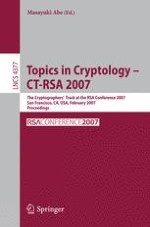The RSA Conference, with over 15,000 attendees and 300 exhibitors, is the largest computer security event of the year. The Cryptographers’ Track (CT- RSA) is a research conference within the RSA Conference. Starting in 2001, CT-RSA continues to its seventh year and is now regarded as one of the major regularly staged event for presenting the results of cryptographic research to a wide variety of audiences. The proceedings of CT-RSA 2007 contain 25 papers selected from 73 s- missions which cover all the topics of cryptography. All the submissions were reviewed by at least three reviewers, which was possible by the hard work of 23 Program Committee members and many external reviewers listed in the foll- ing pages. The papers were selected as a result of conscientious discussion. The program includes two invited talks, by Michel Rabin and Andrew Odlyzko. I would like to express my gratitude to the Program Committee members, whowereenthusiasticfromtheverybeginningofthis completedproject.Thanks also to the external reviewers including those who completed urgent reviews during the discussion phase. Special thanks to Shai Halevi for providing and maintaining the Web review system. Finally, I would like to thank Burt Kaliski of RSA Laboratories and the Steering Committee for their suggestions and c- tinuous assistance.
